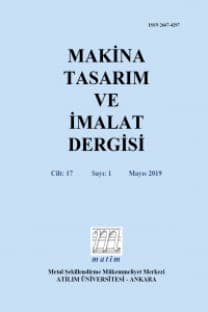Tornalama İşleminde Karbon Emisyonunu En Aza İndiren Bir Modelin Geliştirilmesi
Karbon salınımı, talaşlı imalat, tornalama, Taguchi Yöntemleri, enerji tüketimi
___
- 1. Li, C., Tang, Y., Cui, L., Li, P., A quantitative approach to analyze carbon emissions of CNC-based machining systems, Int. J. Of Advanced Manufacturing Tech., 26 (2015), 911–922.
- 2. Herrmann, C., Thiede, S., Process chain simulation to foster energy efficiency in manufacturing, CIRP Journal of Manufacturing Science and Technology, 1 (2009) 4, 221–229.
- 3. Tian, G. D., Liu, Y. M., Ke, H., Chu, J. W., Energy evaluation method and its optimization models for process planning with stochastic characteristics: A case study in disassembly decision making, Computers and Industrial Engineering, 9(2012) 2, 107– 112.
- 4. Rahimifard, S., Seow, Y., Childs, T., Minimizing embodied product energy to support energy efficient manufacturing, Manufacturing Technology, 59(2010) 1, 25– 28.
- 5. Gutowski, T. G., The carbon and energy intensity of manufacturing, Proceedings of the 40th CIRP international manufacturing systems, 2007.
- 6. Neugebauer, R., Wertheim, R., Harzbecker, C., Energy and resources efficiency in the metal cutting industry, Proceedings of the 8th global conference on sustainable manufacturing, 36, 247–257, 2011.
- 7. Diaz, N., Redelsheimer, E., Dornfeld, D., Energy consumption characterization and reduction strategies for milling machine tool use, Proceedings of 18th CIRP international conference on lifecycle engineering, 263– 267, 2011.
- 8. Jia, S., Tang, R. Z., Lv, J., Therblig-based energy demand modeling methodology of machining process to support intelligent manufacturing, Journal of Intelligent Manufacturing, 25 (2014) 5, 913-931.
- 9. Krishnan, N., Raoux, S., Dornfeld, D., Quantifying the environmental foot print of semiconductor equipment using the environmental value systems analysis (EnVS), IEEE transactions on Semiconductor Manufacturing, 17( 2004) 4, 554–561.
- 10. Jeswiet, J., Kara, S., Carbon emissions and CES in manufacturing, CIRP Annals- Manufacturing Technology, 57 (2008) 1, 17– 20, 2008.
- 11. Tridech, S., Cheng, K., Low carbon manufacturing: Characterisation, theoretical models and implementation, International Journal of Manufacturing Research, 6 (2008) 2, 110–121.
- 12. Diaz, N., Choi, S., Helu, M., Chen, Y. F., Jayanathan, S., Yasui,Y., Kong, D., Pavanaskar, S., Dornfeld, D., Machine tool design and operation strategies for green manufacturing, Proceedings of 4th CIRP international conference on high performance cutting, 1–6, 2010.
- 13. Song, J. S., Lee, K. M., Development of a low-carbon product design system based on embedded GHG emissions, Resources Conservation and Recycling, 54 (2010) 9, 547–556.
- 14. Rajemi, M. F., Mativenga, P. T., Aramcharoen, A., Sustainable machining: Selection of optimum turning conditions based on minimum energy considerations, Journal of Cleaner Production, 18 (2010) 10–11, 1059–1065.
- 15. Le, T. P. N., Lee, T. R., Model selection with considering the CO2 emission alone the global supply chain, Journal of IntelligentManufacturing, 24 (2013) 4, 653- 672.
- 16. Halevi, Y., Carpanzano, E., Montalbano, G., Koren, Y., Minimum energy control of redundant actuation machine tools, Manufacturing Technology, 60 (2011) 1, 433–436.
- 17. Chen, Q. X., Kang, C. Q., Xia, Q., Guan, D. B., Preliminary exploration on low-carbon technology roadmap of China’s power sector, Energy, 36 (2011) 3, 1500–1512.
- 18. Fang, K., Uhana, N., Zhao, F., Sutherland, J. W., A new approach to scheduling in manufacturing for power consumption and carbon footprint reduction, Journal of Manufacturing Systems, 30(2011) 4, 234– 240.
- 19. Duflou, J. R., Sutherland, J. W., Dornfeld, D., Herrmann, C., Jeswiet, J., Kara, S., et al., Towards energy and resource efficient manufacturing: A processes and systems approach, Manufacturing Technology, 61(2012) 2, 587–609.
- 20. Canadell, J. G., Quèrè, C. L., & Raupacha, M. R., Field, C.B., Buitenhuis, E.T., Ciais , P., Conway, T.J., Gillett, N.P., Houghton, R. A., Marland, G., Contributions to accelerating atmospheric CO2 growth from economic activity, carbon intensity, and efficiency of natural sinks, Proceedings of the National Academy of Sciences of the USA, 104(47), 18866–18870, 2007.
- 21. İç, Y.T., Yıldırım, S., Çok Kriterli Karar Verme Yöntemleriyle Birlikte TAGUCHI Yöntemini Kullanarak Bir Ürünün Tasarımının Geliştirilmesi, Gazi Üniv. Müh. Mim. Fak. Der., 27(2012) 2, 447-458.
- 22. Tong, L.I., Chen, C.C., Wang, C.H., Optimization of multi-response processes using the VIKOR method, International Journal of Advanced Manufacturing Technology, 31(2007), 1049–1057.
- 23. Lan, T-S.,Taguchi optimization of multi objective CNC machining using TOPSIS, Information Technology Journal, 8(2009) 6, 917-922.
- ISSN: 1302-9487
- Başlangıç: 1986
- Yayıncı: Makina Tasarım ve İmalat Derneği
Bor Nitrür Kaplamanın, Kaynak Çapaklarının Metal Aparat Yüzeylerine Yapışma Davranışlarına Etkisi
Merih ŞENGÖNÜL, İsmail DURGUN, Nihan DÖKMETAŞ, Hakan KALKAN, Bilgin KAFTANOĞLU
Kanal Fanının İtme Kuvvetinin Deneysel Olarak Hesaplanması
Mehmet Hanifi DOĞRU, İbrahim Halil GÜZELBEY
Emre DORUK, Gürkan YILMAZOĞLU, Zeki AYAZ, Tanya BAŞER, İsmail DURGUN
Tornalama İşleminde Karbon Emisyonunu En Aza İndiren Bir Modelin Geliştirilmesi
Yusuf Tansel İÇ, F. Selin AKKOÇ, Nergis GÜMÜŞBOĞA, Zeynep BALLI
